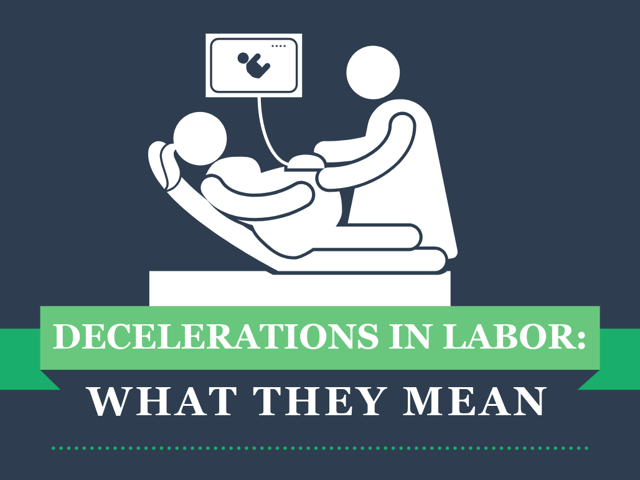
Decelerations in Labor: What They Mean
While caring for a patient in labor, one of the important nursing duties is monitoring the variability of the fetal heart rate (FHR) and monitoring the FHR response during contractions. Variability in the FHR during labor is a sign of fetal well-being or fetal activity or both. The expected variability usually includes slight accelerations and decelerations. However, there are three main deceleration patterns that are important to monitor and differentiate.
Early Decelerations
Early decelerations are shown by FHR gradually decreasing at the start of a contraction and gradually increasing at the end of a contraction. On the monitor, the FHR pattern will mirror the contraction with a “U” shape. As long as the FHR stays within normal range (110–160 bpm), early decelerations are nothing to worry about. They are typically caused by the compression of the head in the birth canal. When observing early decelerations, no interventions are needed, and the nurse should continue to monitor the patient.
Late Decelerations
Late decelerations are shown by the FHR gradually decreasing around the peak of the contraction and gradually increasing when the contraction is over. These decelerations will also have a “U” shape but will not mirror the contractions. The most common cause of late decelerations is uteroplacental insufficiency (insufficient oxygen exchange between the placenta and the fetus). When late decelerations are observed, the nurse should attempt to increase the oxygen delivery to fetus by turning the mother on her left side and/or administering oxygen. If Oxytocin (Pitocin) is being administered, it should be stopped.
Variable Decelerations
Another deceleration pattern that may be concerning is that of variable decelerations. Variable decelerations are marked by a sharp decrease (“V” shape) in FHR that does not correlate to contractions. Umbilical cord compression is usually the cause of variable decelerations. Repositioning of the mother can relieve this compression if it is minor. However, if these decelerations continue, it could be a sign of more serious cord compression, and the nurse should administer oxygen, stop Oxytocin (Pitocin) if applicable, and check for vaginal cord prolapse.
VEAL CHOP
An easy way to remember these different types is to remember the mnemonic VEAL CHOP:
Variable Decelerations
Early Decelerations
Accelerations
Late Decelerations
Cord Compression
Head Compression
Okay
Placental Insufficiency

Keep Reading

National Council Licensure Examination-Registered Nurse Blog
What to Expect in Nursing School Clinicals
The clinical experience is a rite of passage for all nursing students, …

National Council Licensure Examination-Registered Nurse Blog
What is the NCLEX Next Generation (NGN) Exam?
If you’re interested in becoming a registered nurse, you likely know th…

National Council Licensure Examination-Registered Nurse Blog
IDEA for Drugs to Treat Bradycardia/Hypotension
For hospitalized patients, bradycardia (slow heart rate) and hypotensio…